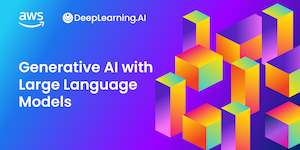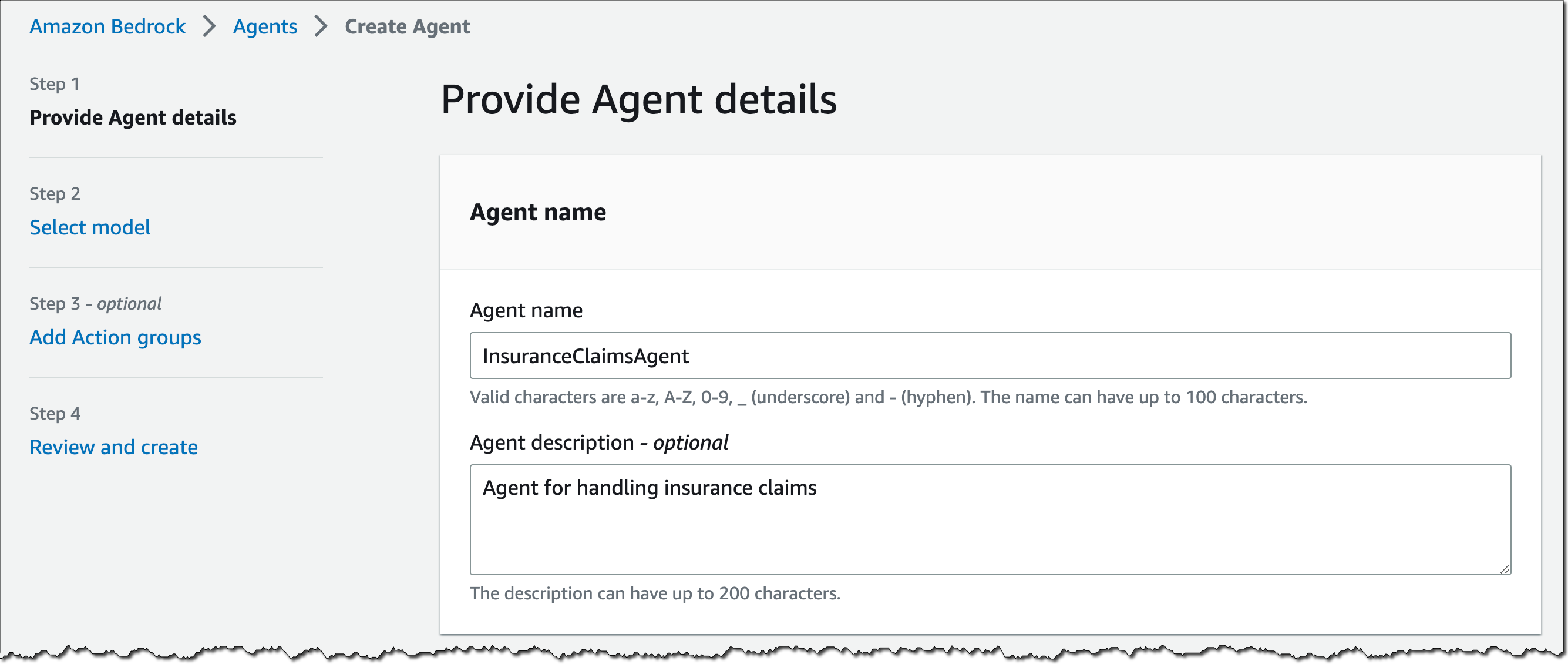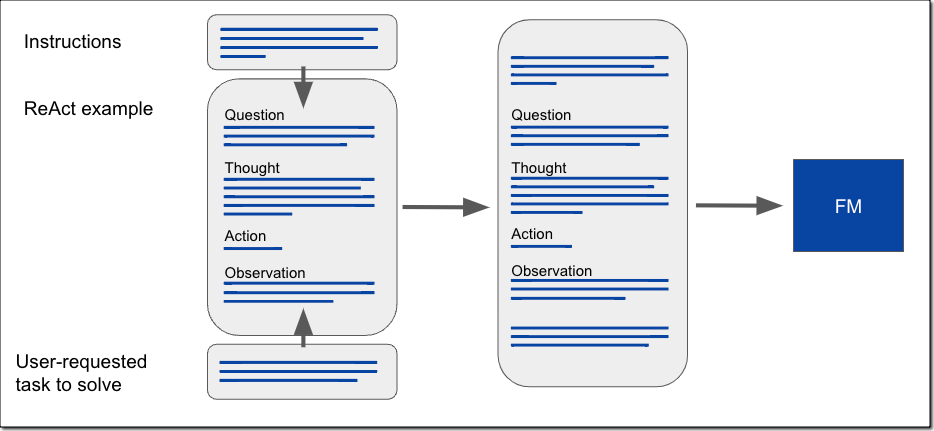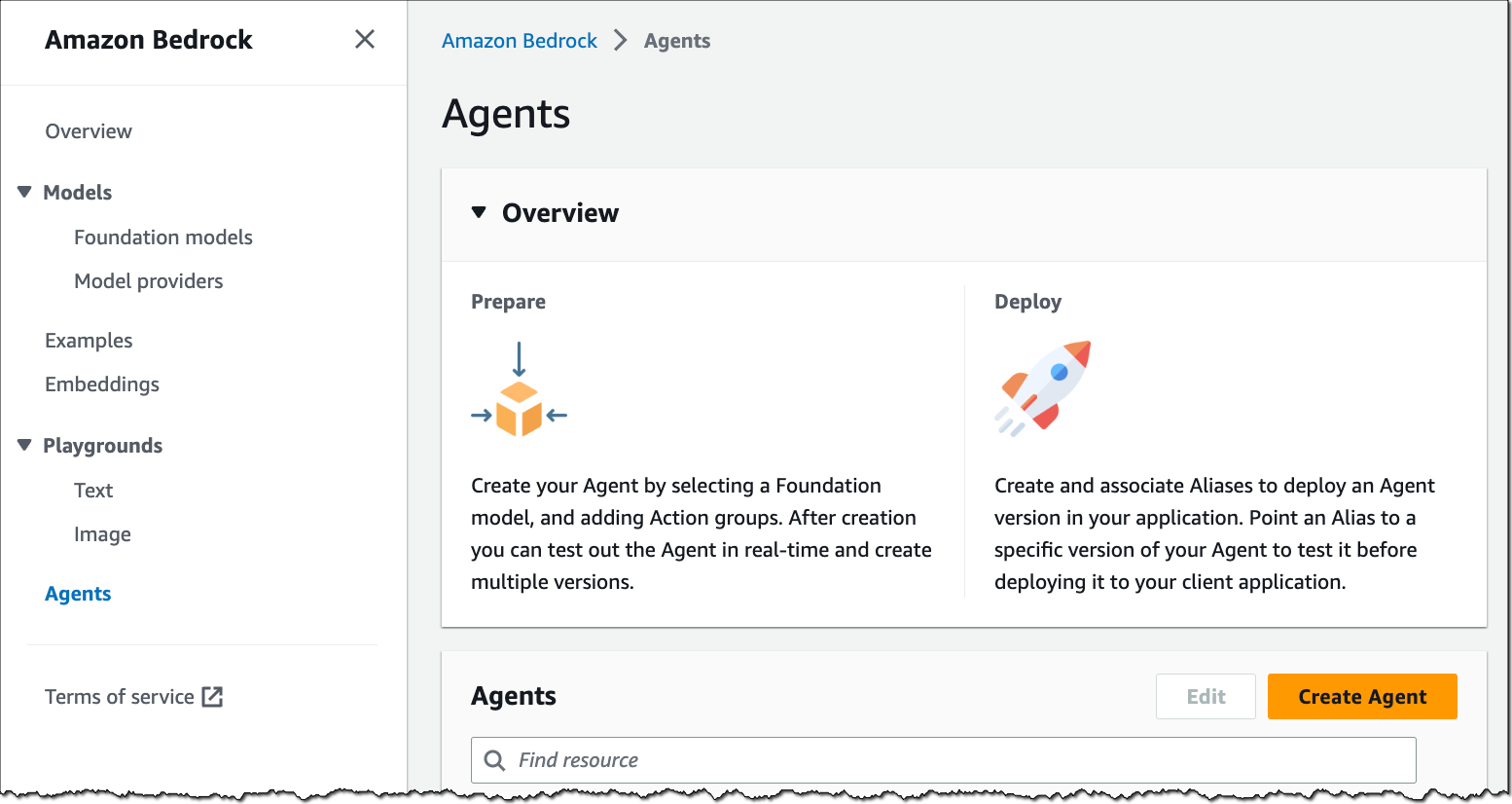This April, Swami Sivasubramanian, Vice President of Information and Machine Studying at AWS, introduced Amazon Bedrock and Amazon Titan fashions as a part of new instruments for constructing with generative AI on AWS. Amazon Bedrock, at present obtainable in preview, is a completely managed service that makes basis fashions (FMs) from Amazon and main AI startups—similar to AI21 Labs, Anthropic, Cohere, and Stability AI—obtainable via an API.
Immediately, I’m excited to announce the preview of brokers for Amazon Bedrock, a brand new functionality for builders to create absolutely managed brokers in a number of clicks. Brokers for Amazon Bedrock speed up the supply of generative AI functions that may handle and carry out duties by making API calls to your organization methods. Brokers prolong FMs to grasp consumer requests, break down advanced duties into a number of steps, keep on a dialog to gather further data, and take actions to meet the request.
Utilizing brokers for Amazon Bedrock, you may automate duties to your inside or exterior prospects, similar to managing retail orders or processing insurance coverage claims. For instance, an agent-powered generative AI e-commerce software cannot solely reply to the query, “Do you might have this jacket in blue?” with a easy reply however may make it easier to with the duty of updating your order or managing an alternate.
For this to work, you first want to provide the agent entry to exterior knowledge sources and join it to current APIs of different functions. This permits the FM that powers the agent to work together with the broader world and prolong its utility past simply language processing duties. Second, the FM wants to determine what actions to take, what data to make use of, and through which sequence to carry out these actions. That is attainable because of an thrilling rising habits of FMs—their potential to motive. You may present FMs easy methods to deal with such interactions and easy methods to motive via duties by constructing prompts that embody definitions and directions. The method of designing prompts to information the mannequin in the direction of desired outputs is named immediate engineering.
Introducing Brokers for Amazon Bedrock
Brokers for Amazon Bedrock automate the immediate engineering and orchestration of user-requested duties. As soon as configured, an agent mechanically builds the immediate and securely augments it together with your company-specific data to offer responses again to the consumer in pure language. The agent is ready to determine the actions required to mechanically course of user-requested duties. It breaks the duty into a number of steps, orchestrates a sequence of API calls and knowledge lookups, and maintains reminiscence to finish the motion for the consumer.
With absolutely managed brokers, you don’t have to fret about provisioning or managing infrastructure. You’ll have seamless assist for monitoring, encryption, consumer permissions, and API invocation administration with out writing customized code. As a developer, you need to use the Bedrock console or SDK to add the API schema. The agent then orchestrates the duties with the assistance of FMs and performs API calls utilizing AWS Lambda features.
Primer on Superior Reasoning and ReAct
You may assist FMs to motive and work out easy methods to resolve user-requested duties with a reasoning approach known as ReAct (synergizing reasoning and performing). Utilizing ReAct, you may construction prompts to indicate an FM easy methods to motive via a job and resolve on actions that assist discover a answer. The structured prompts embody a sequence of question-thought-action-observation examples.
The query is the user-requested job or drawback to resolve. The thought is a reasoning step that helps display to the FM easy methods to deal with the issue and establish an motion to take. The motion is an API that the mannequin can invoke from an allowed set of APIs. The remark is the results of finishing up the motion. The actions that the FM is ready to select from are outlined by a set of directions which can be prepended to the instance immediate textual content. Right here is an illustration of how you’ll construct up a ReAct immediate:
The excellent news is that Bedrock performs the heavy lifting for you! Behind the scenes, brokers for Amazon Bedrock construct the prompts based mostly on the data and actions you present.
Now, let me present you easy methods to get began with brokers for Amazon Bedrock.
Create an Agent for Amazon Bedrock
Let’s assume you’re a developer at an insurance coverage firm and need to present a generative AI software that helps the insurance coverage company house owners automate repetitive duties. You create an agent in Bedrock and combine it into your software.
To get began with the agent, open the Bedrock console, choose Brokers within the left navigation panel, then select Create Agent.
This begins the agent creation workflow.
- Present agent particulars together with agent identify, description (non-compulsory), whether or not the agent is allowed to request further consumer inputs, and the AWS Id and Entry Administration (IAM) service function that provides your agent entry to different required companies, similar to Amazon Easy Storage Service (Amazon S3) and AWS Lambda.

- Choose a basis mannequin from Bedrock that matches your use case. Right here, you present an instruction to your agent in pure language. The instruction tells the agent what job it’s alleged to carry out and the persona it’s alleged to assume. For instance, “You’re an agent designed to assist with processing insurance coverage claims and managing pending paperwork.”

- Add motion teams. An motion is a job that the agent can carry out mechanically by making API calls to your organization methods. A set of actions is outlined in an motion group. Right here, you present an API schema that defines the APIs for all of the actions within the group. You additionally should present a Lambda perform that represents the enterprise logic for every API. For instance, let’s outline an motion group known as ClaimManagementActionGroup that manages insurance coverage claims by pulling a listing of open claims, figuring out excellent paperwork for every declare, and sending reminders to coverage holders. Be sure that to seize this data within the motion group description.
 The enterprise logic for my motion group is captured within the Lambda perform InsuranceClaimsLambda. This AWS Lambda perform implements strategies for the next API calls:
The enterprise logic for my motion group is captured within the Lambda perform InsuranceClaimsLambda. This AWS Lambda perform implements strategies for the next API calls: open-claims,identify-missing-documents, andsend-reminders.Right here’s a brief extract from my OrderManagementLambda:import json import time def open_claims(): ... def identify_missing_documents(parameters): ... def send_reminders(): ... def lambda_handler(occasion, context): responses = [] for prediction in occasion['actionGroups']: response_code = ... motion = prediction['actionGroup'] api_path = prediction['apiPath'] if api_path == '/claims': physique = open_claims() elif api_path == '/claims/{claimId}/identify-missing-documents': parameters = prediction['parameters'] physique = identify_missing_documents(parameters) elif api_path == '/send-reminders': physique = send_reminders() else: physique = {"{}::{} isn't a legitimate api, strive one other one.".format(motion, api_path)} response_body = { 'software/json': { 'physique': str(physique) } } action_response = { 'actionGroup': prediction['actionGroup'], 'apiPath': prediction['apiPath'], 'httpMethod': prediction['httpMethod'], 'httpStatusCode': response_code, 'responseBody': response_body } responses.append(action_response) api_response = {'response': responses} return api_responseNotice that you just additionally should present an API schema within the OpenAPI schema JSON format. Right here’s what my API schema file
insurance_claim_schema.jsonseems like:{"openapi": "3.0.0", "data": { "title": "Insurance coverage Claims Automation API", "model": "1.0.0", "description": "APIs for managing insurance coverage claims by pulling a listing of open claims, figuring out excellent paperwork for every declare, and sending reminders to coverage holders." }, "paths": { "/claims": { "get": { "abstract": "Get a listing of all open claims", "description": "Get the record of all open insurance coverage claims. Return all of the open claimIds.", "operationId": "getAllOpenClaims", "responses": { "200": { "description": "Will get the record of all open insurance coverage claims for coverage holders", "content material": { "software/json": { "schema": { "kind": "array", "gadgets": { "kind": "object", "properties": { "claimId": { "kind": "string", "description": "Distinctive ID of the declare." }, "policyHolderId": { "kind": "string", "description": "Distinctive ID of the coverage holder who has filed the declare." }, "claimStatus": { "kind": "string", "description": "The standing of the declare. Declare may be in Open or Closed state" } } } } } } } } } }, "/claims/{claimId}/identify-missing-documents": { "get": { "abstract": "Establish lacking paperwork for a selected declare", "description": "Get the record of pending paperwork that have to be uploaded by coverage holder earlier than the declare may be processed. The API takes in just one declare id and returns the record of paperwork which can be pending to be uploaded by coverage holder for that declare. This API ought to be known as for every declare id", "operationId": "identifyMissingDocuments", "parameters": [{ "name": "claimId", "in": "path", "description": "Unique ID of the open insurance claim", "required": true, "schema": { "type": "string" } }], "responses": { "200": { "description": "Listing of paperwork which can be pending to be uploaded by coverage holder for insurance coverage declare", "content material": { "software/json": { "schema": { "kind": "object", "properties": { "pendingDocuments": { "kind": "string", "description": "The record of pending paperwork for the declare." } } } } } } } } }, "/send-reminders": { "put up": { "abstract": "API to ship reminder to the shopper about pending paperwork for open declare", "description": "Ship reminder to the shopper about pending paperwork for open declare. The API takes in just one declare id and its pending paperwork at a time, sends the reminder and returns the monitoring particulars for the reminder. This API ought to be known as for every declare id you need to ship reminders for.", "operationId": "sendReminders", "requestBody": { "required": true, "content material": { "software/json": { "schema": { "kind": "object", "properties": { "claimId": { "kind": "string", "description": "Distinctive ID of open claims to ship reminders for." }, "pendingDocuments": { "kind": "string", "description": "The record of pending paperwork for the declare." } }, "required": [ "claimId", "pendingDocuments" ] } } } }, "responses": { "200": { "description": "Reminders despatched efficiently", "content material": { "software/json": { "schema": { "kind": "object", "properties": { "sendReminderTrackingId": { "kind": "string", "description": "Distinctive Id to trace the standing of the ship reminder Name" }, "sendReminderStatus": { "kind": "string", "description": "Standing of ship reminder notifications" } } } } } }, "400": { "description": "Unhealthy request. A number of required fields are lacking or invalid." } } } } } }When a consumer asks your agent to finish a job, Bedrock will use the FM you configured for the agent to establish the sequence of actions and invoke the corresponding Lambda features in the proper order to resolve the user-requested job.
- Within the closing step, assessment your agent configuration and select Create Agent.

- Congratulations, you’ve simply created your first agent in Amazon Bedrock!

Deploy an Agent for Amazon Bedrock
To deploy an agent in your software, it’s essential to create an alias. Bedrock then mechanically creates a model for that alias.
- Within the Bedrock console, choose your agent, then choose Deploy, and select Create to create an alias.

- Present an alias identify and outline and select whether or not to create a brand new model or use an current model of your agent to affiliate with this alias.

- This protects a snapshot of the agent code and configuration and associates an alias with this snapshot or model. You need to use the alias to combine the agent into your functions.

Now, let’s check the insurance coverage agent! You are able to do this proper within the Bedrock console.
Let’s ask the agent to “Ship reminder to all coverage holders with open claims and pending paper work.” You may see how the FM-powered agent is ready to perceive the consumer request, break down the duty into steps (accumulate the open insurance coverage claims, lookup the declare IDs, ship reminders), and carry out the corresponding actions.
Brokers for Amazon Bedrock might help you improve productiveness, enhance your customer support expertise, or automate DevOps duties. I’m excited to see what use circumstances you’ll implement!
 Study the Fundamentals of Generative AI
Study the Fundamentals of Generative AI
For those who’re within the fundamentals of generative AI and easy methods to work with FMs, together with superior prompting methods and brokers, try this this new hands-on course that I developed with AWS colleagues and business consultants in collaboration with DeepLearning.AI:
Generative AI with massive language fashions (LLMs) is an on-demand, three-week course for knowledge scientists and engineers who need to learn to construct generative AI functions with LLMs. It’s the right basis to begin constructing with Amazon Bedrock. Enroll for generative AI with LLMs at this time.
Signal as much as Study Extra about Amazon Bedrock (Preview)
Amazon Bedrock is at present obtainable in preview. Attain out to us for those who’d like entry to brokers for Amazon Bedrock as a part of the preview. We’re recurrently offering entry to new prospects. Go to the Amazon Bedrock Options web page and signal as much as study extra about Amazon Bedrock.
— Antje
P.S. We’re targeted on bettering our content material to offer a greater buyer expertise, and we want your suggestions to take action. Please take this fast survey to share insights in your expertise with the AWS Weblog. Notice that this survey is hosted by an exterior firm, so the hyperlink doesn’t result in our web site. AWS handles your data as described within the AWS Privateness Discover.






